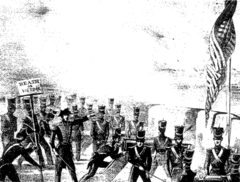Siege of Fort Texas facts for kids
Quick facts for kids Siege of Fort Texas |
|||||||
|---|---|---|---|---|---|---|---|
| Part of Mexican–American War | |||||||
 Major Jacob Brown with his sword, commanding the defenders of Fort Texas, one of which is holding a sign stating, "Death or Victory". |
|||||||
|
|||||||
| Belligerents | |||||||
| Commanders and leaders | |||||||
| Strength | |||||||
| 500 infantry men | 1,600 14 artillery pieces |
||||||
| Casualties and losses | |||||||
| 2 killed 10 wounded |
2 killed 2 wounded 3 prisoners wounded |
||||||
The Siege of Fort Texas was the first big fight between the armies of the United States and Mexico during the Mexican–American War. This battle is sometimes called the Siege of Fort Brown. Major Jacob Brown, an American soldier, was one of two Americans who died in this battle.
What Led to the Siege?
On March 28, 1846, the U.S. Army, led by General Zachary Taylor, arrived at the north bank of the Rio Grande river. General Taylor ordered Captain Joseph K. Mansfield to build a strong fort made of earth. This fort was shaped like a star and could hold 800 soldiers. It was named "Fort Texas."
About 500 soldiers, led by Major Jacob Brown, were stationed at Fort Texas. They had four large 18-pound cannons and other smaller cannons.
Meanwhile, Mexican General Francisco Mejia also built forts. One was called Fort Paredes, and it had twenty cannons. He also built two smaller forts, called redoubts, close to Taylor's camp. These forts could fire at Taylor's camp from two sides, creating a "crossfire."
After a small fight known as the Thornton Affair, Mexican forces led by General Mariano Arista crossed the Rio Grande. They began to surround Fort Texas. This happened after they realized that General Taylor had moved most of his soldiers to Fort Polk to protect his supplies.
The Siege Begins
The Mexican army started firing cannons at Fort Texas at dawn on May 3, 1846. The Americans fired back, and the Mexican cannons stopped for a while. However, Mexican cannons further down the river continued to fire.
The American soldiers tried to set fire to the nearby city of Matamoros using "hot shot" (cannonballs heated until they were red hot). Mexican firing stopped at 7:30 PM, and American firing stopped at 11 PM.
On May 4, Mexican soldiers placed more cannons and a mortar (a type of short cannon that fires shells high into the air) on the north bank of the Rio Grande. On May 5, General Pedro de Ampudia arrived with 1,230 more soldiers and four cannons.
The Mexican cannons were not strong enough to break through the earth walls of Fort Texas. The Mexican soldiers also did not want to attack the fort directly. So, the siege continued until May 9. Mexican cavalry (soldiers on horseback) blocked the road to Point Isabel, stopping supplies from reaching the fort.
Captain Edgar S. Hawkins took command of Fort Texas after Major Brown was badly wounded by a cannonball on May 6. Later that day, General Arista demanded that the fort surrender. Captain Hawkins bravely refused, saying he understood the demand and would not give up.
When General Arista realized that General Taylor was leaving Fort Polk to return to Fort Texas, he moved his army. This led to two more important battles: the Battle of Palo Alto and the Battle of Resaca de la Palma.
After the Battle
The Siege of Fort Texas lasted for six days, with a lot of cannon fire. But surprisingly, not many soldiers were hurt. Only two U.S. soldiers died. Major Brown was hit in the leg by a cannonball on May 6. He died on May 9, just hours before the siege ended. Even with his injury, Major Brown helped keep the soldiers' spirits high, which was important for defending the fort.
Mexican leaders reported that two of their soldiers were killed and two were wounded by American cannon fire. We don't know how many civilians in Matamoros were affected by the artillery fire.
A woman named Sarah Borginnes, who worked as a laundress and cook, became famous during the siege. She refused to hide and instead brought food and coffee to the American troops. American newspapers called her the "Heroine of Fort Brown."
See also
 In Spanish: Sitio de Fort Texas para niños
In Spanish: Sitio de Fort Texas para niños


